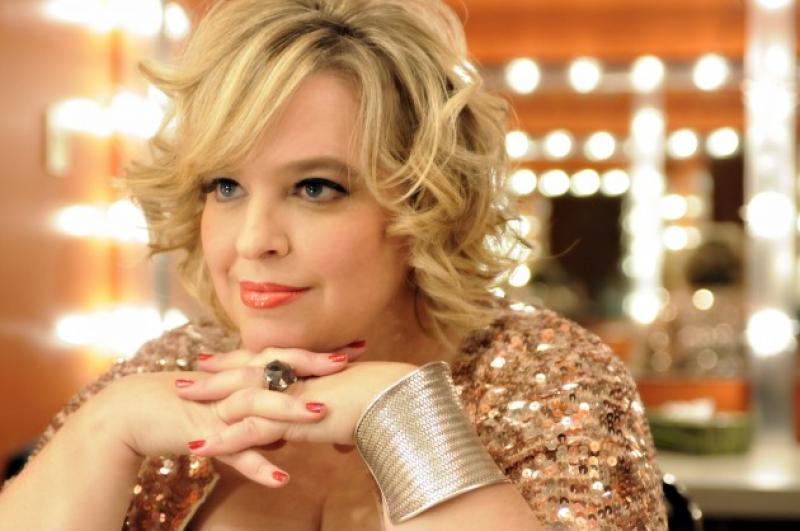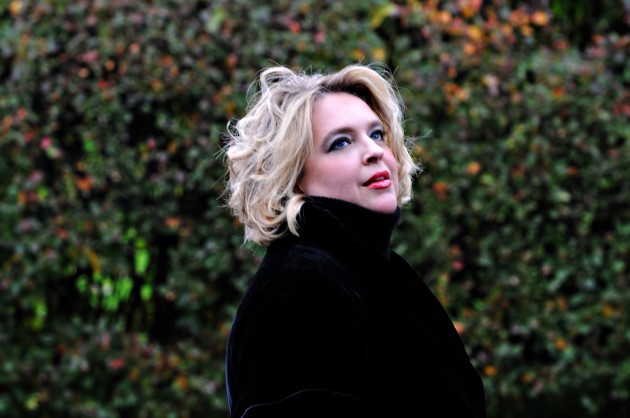Gauvin, Le Concert de la Loge, Chauvin, Wigmore Hall | reviews, news & interviews
Gauvin, Le Concert de la Loge, Chauvin, Wigmore Hall
Gauvin, Le Concert de la Loge, Chauvin, Wigmore Hall
One of baroque's most beautiful voices delivers a flawless Handel recital

Canadian soprano Karina Gauvin has one of the most beautiful voices in the business – a glinting crystal blade sheathed in velvet. She wields it with skill, darting swiftly with coloratura one minute, before stabbing deep with emotion the next. In Handel she’s peerless, and this was an exhibition round of a programme, designed to show both singer and composer at their best.
She was joined by violinist Julien Chauvin and Le Concert de la Loge, the French baroque band who are rapidly becoming the go-to backing group for baroque stars including Philippe Jaroussky and Sandrine Piau. Theirs is a curious sound, softer and woodier than most period ensembles, lacking the percussive rasp and clatter of Les Talens Lyriques or Il Pomo d’Oro. But it’s one well suited to Gauvin’s rounded tone, and (some strident moments from the oboe aside) their musical interplay was sympathetic and instinctive.
It was in the arias that the programme came into focus
There was no over-arching theme here, just a leisurely wander through Handel’s best bits, including two sequences from the Water Music (including some delicate contributions from flautist Tami Krausz and brilliant interventions from a punchy trio of oboes and bassoon), and the gloriously tender violin interplay of Handel’s Concerto Grosso Op 6 No1 (shared between Chauvin and Solenne Guilbert). But it was in the arias that the programme came into focus, elevating this from a satisfying Saturday night to something more.
Gauvin is a recitalist who can bring the opera house into the concert hall. Several hours of conflict, doubt and near-death resolve into the sunny exuberance of Giulio Cesare’s “Da Tempeste”. Here it came, unearned, as an opener. Plunging headlong into Handel’s joyous dance, she carried us with her, her generous, rolling tone filling right into the corners of each note and phrase. Without the anchor of dramatic context it’s easy to default to showy da capo and vocal showmanship in a recital, but Gauvin (picture below) kept Morgana’s flirtatious “Tornami a vagheggiar” from Alcina contained, turning wonder at her skill into wonder at Handel’s skilful understanding of human nature.
 Simplicity was also the hallmark of the tragic arias – Alcina’s “Ah! Mio cor” and Armida’s “Ah! Crudel” from Rinaldo. Holding back, keeping the majority of her power, iceberg-like, below the surface, Gauvin let her uninterrupted line carry the weight of her intent, leaning into legatos that rolled inexorably forwards. Handel’s sorceresses are complex creatures, and in Gauvin’s hands it’s easy to believe them more sinned against than sinning, so dignified are these portraits of grief and regret. But all that was swept aside in the sudden release of “Furie Terribili", a ferocious parting reminder of what happens when the soprano releases her full dramatic force.
Simplicity was also the hallmark of the tragic arias – Alcina’s “Ah! Mio cor” and Armida’s “Ah! Crudel” from Rinaldo. Holding back, keeping the majority of her power, iceberg-like, below the surface, Gauvin let her uninterrupted line carry the weight of her intent, leaning into legatos that rolled inexorably forwards. Handel’s sorceresses are complex creatures, and in Gauvin’s hands it’s easy to believe them more sinned against than sinning, so dignified are these portraits of grief and regret. But all that was swept aside in the sudden release of “Furie Terribili", a ferocious parting reminder of what happens when the soprano releases her full dramatic force.
The Wigmore spoils its audience with vocal recitals, but even so, this was something special. What a shame that so many seats went unfilled. Gauvin’s may not be a household name in the UK, but that’s very much our loss, not hers.
rating
Explore topics
Share this article
The future of Arts Journalism
You can stop theartsdesk.com closing!
We urgently need financing to survive. Our fundraising drive has thus far raised £49,000 but we need to reach £100,000 or we will be forced to close. Please contribute here: https://gofund.me/c3f6033d
And if you can forward this information to anyone who might assist, we’d be grateful.

Subscribe to theartsdesk.com
Thank you for continuing to read our work on theartsdesk.com. For unlimited access to every article in its entirety, including our archive of more than 15,000 pieces, we're asking for £5 per month or £40 per year. We feel it's a very good deal, and hope you do too.
To take a subscription now simply click here.
And if you're looking for that extra gift for a friend or family member, why not treat them to a theartsdesk.com gift subscription?
more Classical music
 Lammermuir Festival 2025, Part 2 review - from the soaringly sublime to the zoologically ridiculous
Bigger than ever, and the quality remains astonishingly high
Lammermuir Festival 2025, Part 2 review - from the soaringly sublime to the zoologically ridiculous
Bigger than ever, and the quality remains astonishingly high
 BBC Proms: Ehnes, Sinfonia of London, Wilson review - aspects of love
Sensuous Ravel, and bittersweet Bernstein, on an amorous evening
BBC Proms: Ehnes, Sinfonia of London, Wilson review - aspects of love
Sensuous Ravel, and bittersweet Bernstein, on an amorous evening
 Presteigne Festival 2025 review - new music is centre stage in the Welsh Marches
Music by 30 living composers, with Eleanor Alberga topping the bill
Presteigne Festival 2025 review - new music is centre stage in the Welsh Marches
Music by 30 living composers, with Eleanor Alberga topping the bill
 Lammermuir Festival 2025 review - music with soul from the heart of East Lothian
Baroque splendour, and chamber-ensemble drama, amid history-haunted lands
Lammermuir Festival 2025 review - music with soul from the heart of East Lothian
Baroque splendour, and chamber-ensemble drama, amid history-haunted lands
 BBC Proms: Steinbacher, RPO, Petrenko / Sternath, BBCSO, Oramo review - double-bill mixed bag
Young pianist shines in Grieg but Bliss’s portentous cantata disappoints
BBC Proms: Steinbacher, RPO, Petrenko / Sternath, BBCSO, Oramo review - double-bill mixed bag
Young pianist shines in Grieg but Bliss’s portentous cantata disappoints
 theartsdesk at the Lahti Sibelius Festival - early epics by the Finnish master in context
Finnish heroes meet their Austro-German counterparts in breathtaking interpretations
theartsdesk at the Lahti Sibelius Festival - early epics by the Finnish master in context
Finnish heroes meet their Austro-German counterparts in breathtaking interpretations
 Classical CDs: Sleigh rides, pancakes and cigars
Two big boxes, plus new music for brass and a pair of clarinet concertos
Classical CDs: Sleigh rides, pancakes and cigars
Two big boxes, plus new music for brass and a pair of clarinet concertos
 Waley-Cohen, Manchester Camerata, Pether, Whitworth Art Gallery, Manchester review - premiere of no ordinary violin concerto
Images of maternal care inspired by Hepworth and played in a gallery setting
Waley-Cohen, Manchester Camerata, Pether, Whitworth Art Gallery, Manchester review - premiere of no ordinary violin concerto
Images of maternal care inspired by Hepworth and played in a gallery setting
 BBC Proms: Barruk, Norwegian Chamber Orchestra, Kuusisto review - vague incantations, precise laments
First-half mix of Sámi songs and string things falters, but Shostakovich scours the soul
BBC Proms: Barruk, Norwegian Chamber Orchestra, Kuusisto review - vague incantations, precise laments
First-half mix of Sámi songs and string things falters, but Shostakovich scours the soul
 BBC Proms: Alexander’s Feast, Irish Baroque Orchestra, Whelan review - rapturous Handel fills the space
Pure joy, with a touch of introspection, from a great ensemble and three superb soloists
BBC Proms: Alexander’s Feast, Irish Baroque Orchestra, Whelan review - rapturous Handel fills the space
Pure joy, with a touch of introspection, from a great ensemble and three superb soloists
 BBC Proms: Moore, LSO, Bancroft review - the freshness of morning wind and brass
English concert band music...and an outlier
BBC Proms: Moore, LSO, Bancroft review - the freshness of morning wind and brass
English concert band music...and an outlier
 Willis-Sørensen, Ukrainian Freedom Orchestra, Wilson, Cadogan Hall review - romantic resilience
Passion, and polish, from Kyiv's musical warriors
Willis-Sørensen, Ukrainian Freedom Orchestra, Wilson, Cadogan Hall review - romantic resilience
Passion, and polish, from Kyiv's musical warriors

Add comment